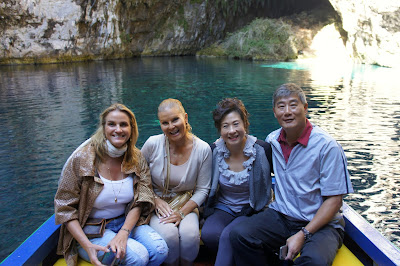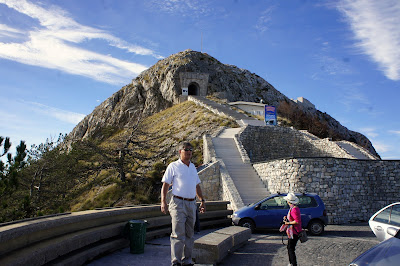Argostoli, Greece:
Situated where the European and Aegean plates meet, this area suffered catastrophic damage during August of 1953 when actually 4 quakes hit the island of Kefalonia
We teamed up with two energetic ladies (Joyce and Karen) from our ship, pitched our plan to a local cab driver and beat all the tour buses to each destination of note ..was a wonderfully efficient day of excursion capped off late afternoon in a gorge-fest of grilled fish, local produce and Robola (white wine of Cephalonia)
Getting excited as I descend the steps to see Drogarati Cave, a dinosaur-era cave (100 millions yrs old) only discovered 300 years ago when a strong earthquake created an opening. Speleologists have confirmed that the cave has an extension, however, not approachable via current technology.


There is a 'Sala of Apotheosis' of perfect acoustics down under the depth ~ 60 meters from ground level, ~ 90% humidity. Here I stand on a natural balcony in front of the big hall where Maria Callas must have performed the opera amid her fans.



Back into our cab taking in views of this enticing Ionian coastline.. stopping briefly in the nearby seaport town. We are late for the season - most shops and restaurant have closed up . But still great day for initial exploring & conjuring up of future escapades ;)




 Backed by steep limestone cliffs, the one-mile stretch of white dramatic sliver shaped beach consisting of white pebbles gave off a dazzling view against the variegated blue hues of sea and sky.
Backed by steep limestone cliffs, the one-mile stretch of white dramatic sliver shaped beach consisting of white pebbles gave off a dazzling view against the variegated blue hues of sea and sky.
Check out Argostoli's own 'leaning tower' like Pisa


At the end of our ride. But the daylight was still with us. Sipping Robola and dining on fresh local olives & seafood..we didn't want to give up the day...yet finally heeded our watches and strolled towards the ship as the sunlight waned by the distant hills of Argostoli - we shall be back :)

Kotor, Montenegro:
We met up with a well travelled couple who gave us the inside scope to this next stop - Kotor.Meeting up early for breakfast for a spectacular sail in aboard the veranda of Oceania Riveria, we took in the serene views from this southernmost fjord of Europe.
The Oceania ship sailed quietly by the famed "Our Lady of the Rocks". Legend tells of the formation of the two inslets ..it is said that back in 1400s a picture of the Virgin Mary and Christ-child was found there.. henceforth sailors after sailors from the town of Perast after every successful voyage would lay a rock in this very spot so that a church could be built atop it. This eventually came to pass..as the traditions continued down the centuries (even to this day - festival of Fasinada) and formed the islet, Serbians first founded a tiny church and was later converted into a Roman Catholic Church.
Just sailing through this inlet, craggy mountains protecting the pathway, the air changes minutely as the sun and wind and mist plays with the colors of the gently sea and sky. It is not hard to fathom the inspirational quality this area must have possessed over the eras to infuse its settlers with much mystical spirit & storied legends.


Finally docking by the Bay of Kotor. Several options await us, the uninitiated. Plenty to explore in the old town itself, or do the obligatory climb to the top of the fortress of > 1000 steps, visit the Sveti Tripun Cathedral or check out the Renaissaance little town of Perast.
We decided to forgo all the usual options and took up the invitation from our fellow passengers ( Ingrid and Chris) to travel with them up the hills high atop the Bay of Kotor. They mapped out the destinations of Cetinje and Njegusi - seemed like random letters cobbled together in a foreign tongue we couldn't even try to pronounce. Well, why not - tempting adventure not to be missed!
Our driver took the famous narrow old roads of 'Lovcens serpentines' aptly named due to its 25 curves over 25 km as we ascended the mountain...


As we got up to this altitude of around 900m , yet still so close to the sea, we gained a birds eye view of the bay and our ship. The air was refreshingly cooler, and as we lifted our gaze...an alluring vista unravelled, the clouds lined up in a dance and the sky just seemed to sing to us!
En route to the Mount Lovcen mausoleum, we paused in the nearby farming village for a spot of coffee and local prosciutto...then it was back into the car for more incredible views and hairpin turns til we arrived at Montenegro's supreme Prince-Bishop and poet, Petar II Pretovic-Njegos' tomb - a grand mausoleum designed by Ivan Mestrovic although Njegos' own request was to be interred in humble chapel. Subsequent wars destroyed his tiny chapel thus his body was moved to this mountaintop chamber.
Petar Njegos was and apparently still is a much revered and beloved philosopher, poet, spiritual, cultural and military leader born in this mountain village of Njegusi (1782-1830). Credited with uniting quarreling tribes around Montenegro and consolidating lands, introducing regime of laws and modern political concepts ( taxation), he is venerated as an icon who tried to unite and liberate the Serbian people.
Cetinje was founded in the 15th C and became the cultural centre and the old capital of Montenegro ( now in Podogrica)

Since we are here, why not do a quick walk through King Nikola's Palace - for more than 50 yrs was seat of Montenegrin Royal family until monarchy was dissolved in 1918... gave us a glimpse of Balkan life.
About 30 min drive from Cetinje and we arrived at a jewel of Montenegrin tourism - Budva. Seeing as this is our last stop before rejoining our ship, a preview of the vicinity was all we were able to fit in before the sunlight settled into an amber glow

Zadar, Croatia:
Being outside of the season, we had the luxury to experience a free run of the national park. Other than encountering a few fellow stragglers along the wooden boardwalk paths, we had virtual privacy and serenity to contemplate the natural beauty of the many travertine waterfalls... big and small cascades formed of karst landscape supported by banks strewn with fertile fauna, moss and algae
Time to test out camera skills - how low can I maintain a minimal shutter speed by just manually holding still ( san tripods or aids) ...love that silkened effect :-)
'The clearest way into the Universe is through a forest wilderness' -John Muir
Our day started out with an abundance of autumn sun, but in the valley of the park trails shade was prevalent
At the main drop Skradinski Buk where in peak season you can swim in this big plunge pool
It would be worthwhile to return and spend more time here to explore the waterways via a boat ride which can transport visitors to the town of Skradin and the other scenic spots in this extensive preserve : Rosi Slap, Necklace Cascades, Island of Visovac & monastery, not to mention the city of Split... yes, the world is a big place..so much to explore!

'what mystical cascade chattering with rocks and moss, slipping through the trees' ...- anonymous
'Peaceful mind is flowing mind. Beautiful heart is smiling heart'
Beyond the main watery theater, our path led to a charming village area where mega tourists during peak season surely would come to picnic and visit its small museums, cafes and lookouts. There is even the remains of Krka Hydropower Plant ( from WWI), Much of the watermills have been turned into souvenir ships, and heritage site of various demonstrations in the summertime (display of wheat mills, garment weaving and horsehoes smithshop)
The day has quickly drawn to a close - our last view atop the national park as we pulled out of Krka

Back to the town of Zadar to rejoin the last shuttle from Oceania to board our ship. We had just sufficient time to marvel at the Sea Organ (morske orgulje) located on the shores of Zadar. It's the world's first musical pipe organ that is played by nature - the sea! Hauntingly beautiful and elegantly simple melodies intone with our steps along the quayside. How do they do that ? Underneath the long series of concrete steps (6 or 7) stretching out to sea lay 35 organ pipes (70 meters long). The undulating tidal waves and winds wafting from the sea create never-ending variations of natural musical score - brilliant! Coupled with the visual Sun Salutation circle lit up by photovoltaic cells (solar powered) interspersed with LEDs that burst into light when the sun sets, the Zadar waterfront public art pavilion (installed 2005) is both imaginative & innovative.
Koper, Slovenia:
Increasingly, the more one gets to venture out to port, the smaller one feels .. we're like a couple of ants making our way to see this world ..lol
Docked by Koper shore in the morning. By this time some of the morning mist had already lifted. Our morning was veiled in heavy fog as we road a shuttle bus to the nearby towns of Izola, Piran & Portoroz. This large Adriatic peninsula (Istria) between the gulfs of Trieste and Kvarner is a melding of three cultures : Croatia, Slovenia and Italia
As we arrived so late in the season, our choice of excursion for the aft to UNESCO Skocjan caves was in fact cancelled due to lack to registered visitors. Lake Bled or picturesque Ljublijana would have been earlier possibilities as well, albeit both involved longer treks...due to the misty climate, we opted to investigate the local option to wander around the heritage sites of Piran & Koper proper itself



Coastal walkway from end to end lined with cafes and restaurants offering endless sea views....
Before ascent to Baroque church and bell tower in Piran for wonderful views of the city, the Adriatic and Slovenia coastline..still misty though

Church of St. George interior - fully renovated. Note the large medieval wooden crucifix ..looks centuries old

Paid modest 2 euro to climb the campanile that overlooks the city and coastline


Below Tartini Square is the largest main square in Piran - named after the violinist and composer Giuseppe Tartini whose bronze monument stands since 1896

 Ok, back in Koper...lets take some pics now the crowds have left us...Praetorian Palace ( can't help but conjure up the image of Shrek from Dreamworks - evil prince charming's cartoon castle..lol)
Ok, back in Koper...lets take some pics now the crowds have left us...Praetorian Palace ( can't help but conjure up the image of Shrek from Dreamworks - evil prince charming's cartoon castle..lol) Our walk about took us to Carpaccio square (above birthplace of Venetian painter Vittore Carpaccio) & the Taverna ( former salt storage building). Delighted in taking in these Istria cultural sights and afterwards we sat down for a beautiful plate of grilled fresh catches by the harborside

Noticed the trend here of green plant canopies atop door entrance ways ... well tended and trimmed












































































































